
135 film
Encyclopedia
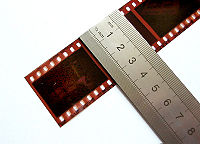
Photography
Photography is the art, science and practice of creating durable images by recording light or other electromagnetic radiation, either electronically by means of an image sensor or chemically by means of a light-sensitive material such as photographic film...
. It quickly grew in popularity, surpassing 120 film
120 film
120 is a film format for still photography introduced by Kodak for their Brownie No. 2 in 1901. It was originally intended for amateur photography but was later superseded in this role by 135 film...
by the late 1960s to become the most popular photographic film format. Despite competition from formats such as 828
828 film
828 is a film format for still photography. Kodak introduced it in 1935, only a year after 135 film. 828 film was introduced with the Kodak Bantam, a consumer-level camera....
, 126
126 film
126 is the number given to a cartridge-based film format used in still photography. It was introduced by Kodak in 1963, and is associated mainly with low-end point-and-shoot cameras, particularly Kodak's own Instamatic series of cameras....
, 110
110 film
110 is a cartridge-based film format used in still photography. It was introduced by Kodak in 1972. 110 is a miniaturised version of Kodak's earlier 126 film format. Each frame is , with one registration hole....
, and APS
Advanced Photo System
Advanced Photo System is a film format for still photography first produced in 1996. It was marketed by Eastman Kodak under the brand name Advantix, by FujiFilm under the name Nexia, by AgfaPhoto under the name Futura and by Konica as Centuria.- Design :The film is 24 mm wide, and has three...
, it remains so today.
135 camera film always comes perforated with Kodak Standard perforations. This effectively eliminates such films from being "diverted" to professional 35mm uses, where Bell & Howell perforations are standard. 135 camera film (negative or reversal), if passed through a 35mm professional motion picture camera, will pass undamaged, but it will not pass with the expected and required registration accuracy for such professional uses.
The size of the 135 film frame has been adopted by many high-end digital single-lens reflex camera
Digital single-lens reflex camera
Most digital single-lens reflex cameras are digital cameras that use a mechanical mirror system and pentaprism to direct light from the lens to an optical viewfinder on the back of the camera....
s, referred to as full-frame digital SLRs.
Cassette
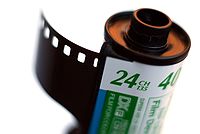
Flocking (texture)
Flocking is the process of depositing many small fiber particles onto a surface. It can also refer to the texture produced by the process, or to any material used primarily for its flocked surface. Flocking of an article can be performed for the purpose of increasing its value in terms of the...
. The end of the film is cut on one side to form a leader. It has the same dimensions and perforation pitch as 35 mm movie print film
35 mm film
35 mm film is the film gauge most commonly used for chemical still photography and motion pictures. The name of the gauge refers to the width of the photographic film, which consists of strips 35 millimeters in width...
(also called "long pitch", whereas 35mm professional motion picture camera films are always "short pitch").
Ordinarily, the film must be rewound before the camera can be opened. Some motorized cameras unwind the film fully upon loading and then expose the images in reverse order, returning the film to the cassette; this protects exposed film except the one or two last images, should the camera back be accidentally opened. In disposables, the film is also fully unwound at start and exposing the images returns the film to the cassette.
Since the 1980s, film cassettes have been marked with a DX encoding
DX encoding
DX encoding is an ANSI and I3A standard, originally introduced by Kodak in March 1983, for marking 135 and APS photographic film and film cartridges...
pattern for automatically setting the camera to use the correct sensitivity value for the film. Different films are sensitive to light at different degrees; this film speed
Film speed
Film speed is the measure of a photographic film's sensitivity to light, determined by sensitometry and measured on various numerical scales, the most recent being the ISO system....
is standardised by ISO
International Organization for Standardization
The International Organization for Standardization , widely known as ISO, is an international standard-setting body composed of representatives from various national standards organizations. Founded on February 23, 1947, the organization promulgates worldwide proprietary, industrial and commercial...
. As of today, common film speeds for consumers are ISO 100/21° through ISO 800/30°, although films with more or less sensitivity are available for professional use.
Image format
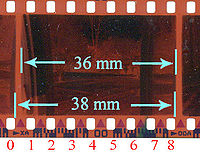
Other image formats are also used, such as the half-frame
Half-frame camera
A half-frame camera is a camera using a film format at half the intended exposure format. A common variety is the 18x24mm format on regular 135 film. It is the normal exposure format on 35mm movie cameras...
format of 18×24 mm that earned some popularity in the 1960s, and the 24×24 mm of the Robot cameras. The successful range of Olympus Pen
Olympus Pen
The Pen series is a family of half-frame cameras made by Olympus from 1959 to the beginning of the 1980s, and from 2009. Aside from the Pen F series of half-frame SLRs, they are fixed-lens viewfinder cameras....
cameras with the smaller half-frame size allowed a very compact pocket-sized camera.
Odd formats include the 24×32 mm and 24×34 mm on the early Nikon rangefinders
Rangefinder camera
A rangefinder camera is a camera fitted with a rangefinder: a range-finding focusing mechanism allowing the photographer to measure the subject distance and take photographs that are in sharp focus...
, and 24×23 mm for use with some stereo camera
Stereo camera
A stereo camera is a type of camera with two or more lenses with a separate image sensor or film frame for each lens. This allows the camera to simulate human binocular vision, and therefore gives it the ability to capture three-dimensional images, a process known as stereo photography. Stereo...
s. In 1967, the Soviet KMZ factory
Krasnogorskiy Zavod
Krasnogorskiy zavod im. S. A. Zvereva is a Russian factory in Krasnogorsk near Moscow which specializes in optical technology.During the Soviet period it was called Krasnogorsk Mechanical Works...
introduced a 24×58 mm panoramic format with its Horizont
Horizont
The Horizont is a mechanical swing-lens panoramic camera. produced in the Soviet Union in the 1960s, it has an all-metal, rectangular body and removable grip and viewfinder.First introduced at Photokina in 1966.Film : 35mm filmPicture size : 24 x 58mm...
camera (descendants of which are called, in the Roman alphabet, Horizon
Horizon (camera)
The Horizon is a mechanical swing-lens panoramic camera. It is manufactured by Krasnogorskiy Zavod in Krasnogorsk, Russia, better-known for their range of Zenit cameras.Cameras with similar functions include the Noblex and Widelux....
). In 1998, Hasselblad
Hasselblad
Victor Hasselblad AB is a Swedish manufacturer of medium-format cameras and photographic equipment based in Gothenburg, Sweden.The company is best known for the medium-format cameras it has produced since World War II....
and Fuji
Fujifilm
is a multinational photography and imaging company headquartered in Tokyo, Japan.Fujifilm's principal activities are the development, production, sale and servicing of color photographic film, digital cameras, photofinishing equipment, color paper, photofinishing chemicals, medical imaging...
introduced a 24×65 mm panoramic format with the XPan/TX-1 camera. There is also a 21×14 mm format used by Tessina subminiature camera.
The perforation
Film perforations
Film perforations, also known as perfs, are the holes placed in the film stock during manufacturing and used for transporting and steadying the film. Films may have different types of perforations depending on film gauge, film format, and the intended usage...
size and pitch are according to the standard specification KS-1870. For each full frame, the film advances 8 perforations. This is specified as 1.4960 inches (approximately 38.00 mm). This allows for 2 mm gaps between frames. Each camera model has a different location for the sprocket which advances the film. Therefore each camera model’s frame will vary in position relative to the perforations. The film is approximately 0.14 mm thick.
Length
The film is available in lengths for varying numbers of exposures. The standard full-length roll has always been 36 exposures (assuming a standard 24×36 frame size). Through about 1980, 20 exposure rolls were the only shorter length with widespread availability. Since then, 20 exposure rolls have been largely discontinued in favour of 24 and 12 exposure rolls. With most cameras it's in fact possible to get 3 more exposures than the nominal capacity on the film if the camera is loaded in a darkroom and some cameras allow this with daylight loading. 27 exposure disposable cameras are loaded in the dark with standard 24 exposure cassette.Other, mostly shorter lengths have been manufactured. There have been some 6, 8, 10, and 15 exposure rolls given away as samples, sometimes in disposable camera
Disposable camera
The disposable or single-use camera is a simple box camera sold with a roll of film installed, meant to be used once. Most use fixed-focus lenses. Some are equipped with an integrated flash unit, and there are even waterproof versions for underwater photography...
s, or used by insurance adjusters to document damage claims. Photographers who load their own cassettes can use any length of film – with thinner film base up to 45 exposures will fit.
Ilford
Ilford Photo
Ilford Photo is a manufacturer of photographic materials known worldwide for its black-and-white film and papers and chemicals, as well as its range of Ilfochrome and Ilfocolor colour printing materials. Ilfochrome was formerly called Cibachrome, developed in partnership with the Swiss company...
at one time made HP5
Ilford HP
HP is a cubic-grain black-and-white film from Ilford Photo with a long history. It originated as Hypersensitive Panchromatic plates in 1931. Since then it progressed through a number of versions, with HP5 plus being the latest...
black-and-white film on a thin polyester base, which allowed 72 exposures in a single cassette. They produced special reels and tanks to allow this to be processed.
Earliest 35 mm still cameras
The 35 mm film standard for motion picture film was established in Thomas EdisonThomas Edison
Thomas Alva Edison was an American inventor and businessman. He developed many devices that greatly influenced life around the world, including the phonograph, the motion picture camera, and a long-lasting, practical electric light bulb. In addition, he created the world’s first industrial...
's lab by William Kennedy Laurie Dickson. Mr. Dickson took 70 mm film stock supplied by George Eastman
George Eastman
George Eastman was an American innovator and entrepreneur who founded the Eastman Kodak Company and invented roll film, helping to bring photography to the mainstream...
's Eastman Kodak Company. The 70 mm film was cut lengthwise into two equal width (35 mm) strips, spliced together end to end, and then perforated along both edges. The original picture size was 18 x 24 mm, which in modern times is considered to be a "half-frame" format for still photography. There were four perforations on each side of a motion picture frame.
While the Leica camera popularized the format (see below), there were a number of 35 mm still cameras using perforated movie film before its introduction in the 1920s. The first patent for one was issued to Leo, Audobard and Baradat in England in 1908. The first full scale production camera was the Homeos, a stereo camera, produced by Jules Richard in 1913. It took stereo pairs, 18x24 mm, with two Tessar lenses, and was sold until 1920.
The first big-selling 35 mm still camera was the American Tourist Multiple, which also appeared in 1913, at a cost of $175 (at today's prices, the same cost as a modern $3000 Leica.) The first camera to take full frame 24x36 mm exposures seems to be the Simplex, introduced in the U.S. in 1914. It took either 800 half frame or 400 full frame shots on 50 ft (15.2 m) rolls.
The Minigraph, by Levy-Roth of Berlin, another half frame small camera was sold in Germany in 1915. The patent for the Debrie Sept camera, a combination 35 mm still and movie camera was issued in 1918, but was not marketed until 1922.
Finally, the Furet camera (made and sold in France in 1923) took full frame 24x36 mm negatives and was the first cheap small 35 mm camera to look vaguely like today's models.
Leicas
The Leica camera designed by Oskar BarnackOskar Barnack
Oskar Barnack was a German optical engineer, precision mechanic, industrial designer and the father of 35mm photography....
used 35 mm film, and proved that a format as small as 24 mm × 36 mm was suitable for professional photography.
Although Barnack designed his prototype camera around 1913, the first experimental production run of ur-Leicas (Serial No. 100 to 130) did not take place until 1923. Full scale production of the Leica did not begin until 1925. While by that time there were at least a dozen other 35 mm cameras available, the Leica was a success, and came to be associated with the format. The success of the Leica was attributed by contemporary photographic writers not only to the quality of its lens, its small size, and the precision of its construction, but also to its relatively high price, which established it as a "prestige" item amongst both photographers and people of fashion.
Pre loaded cassettes and Kodak Retina cameras
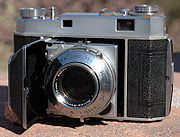
Contax
Contax was a camera brand noted for its unique technical innovation and a wide range of Zeiss lenses, noted for their high optical quality. Its final incarnation was a line of 35 mm, medium format and digital cameras engineered and manufactured by Kyocera, and featuring modern Zeiss optics...
cameras along with the camera for which it was invented, namely the Kodak Retina
Kodak Retina
Retina was the name of a long-running series of German-built Kodak cameras. Retinas were manufactured in Stuttgart by Nagel Camerawerk, which Kodak had acquired in 1931, and sold under the Kodak nameplate. Retinas were noted for their compact size, quality, and low cost compared to their...
camera. The Retina camera and this daylight loading cassette were the invention of Dr. August Nagel of the Kodak AG Dr. Nagel Werk in Stuttgart
Stuttgart
Stuttgart is the capital of the state of Baden-Württemberg in southern Germany. The sixth-largest city in Germany, Stuttgart has a population of 600,038 while the metropolitan area has a population of 5.3 million ....
. Kodak bought Dr. August Nagel's company in December, 1931, and began marketing the Kodak Retina in the summer of 1934. The first Kodak Retina camera was a Typ 117. The 35 mm Kodak Retina camera line remained in production until 1969. Kodak also introduced a line of American made cameras that were simpler and more economical than the Retina. Argus
Argus (camera company)
Argus is an American maker of cameras and photographic products, founded in 1936 in Ann Arbor, Michigan. Argus originated as a subsidiary of the International Radio Corporation , founded by Charles Verschoor. Its best-known product was the C3 rangefinder camera, which enjoyed a 27-year production...
, too, made a long lived range of 35mm cameras; notably the Argus C3
Argus C3
The Argus C3 was a low-priced rangefinder camera mass-produced from 1939 to 1966 by Argus in Ann Arbor, Michigan, USA. The camera was the best-selling 35mm camera in the world for nearly three decades, and helped popularize the 35mm format...
. Kodak launched 135-format Kodachrome
Kodachrome
Kodachrome is the trademarked brand name of a type of color reversal film that was manufactured by Eastman Kodak from 1935 to 2009.-Background:...
color film in 1935. AGFA
Agfa-Gevaert
Agfa-Gevaert N.V. is a European multinational corporation that develops, manufactures, and distributes analogue and digital imaging products and systems, as well as IT solutions. The company has three divisions. Agfa Graphics offers integrated prepress and industrial inkjet systems to the...
followed with the introduction of Agfacolor-Neu in 1936.
The designations 235 and 435 refer to 35 mm film in daylight-loading spools, that could be loaded into Leica or Contax style reusable cassettes without need of a darkroom
Darkroom
A darkroom is a room that can be made completely dark to allow the processing of light sensitive photographic materials, including photographic film and photographic paper. Darkrooms have been created and used since the inception of photography in the early 19th century...
. The 335 was a daylight loading spool for the 24 × 23 mm stereo format.
The reflex camera

Single-lens reflex camera
A single-lens reflex camera is a camera that typically uses a semi-automatic moving mirror system that permits the photographer to see exactly what will be captured by the film or digital imaging system, as opposed to pre-SLR cameras where the view through the viewfinder could be significantly...
(SLR) was the Kine Exakta
Exakta
The Exakta is a pioneer brand camera produced by the Ihagee Kamerawerk in Dresden, Germany, founded as the Industrie und Handels-Gesellschaft mbH, in 1912.- Characteristics :Highlights of Exakta cameras include:...
, introduced in 1936. World War II
World War II
World War II, or the Second World War , was a global conflict lasting from 1939 to 1945, involving most of the world's nations—including all of the great powers—eventually forming two opposing military alliances: the Allies and the Axis...
interrupted development of the type. After the war, Exakta resumed development and the Contax S model with the now familiar pentaprism
Pentaprism
A pentaprism is a five-sided reflecting prism used to deviate a beam of light by 90°. The beam reflects inside the prism twice, allowing the transmission of an image through a right angle without inverting it as an ordinary right-angle prism or mirror would.The reflections inside the prism are not...
viewing feature was introduced in 1949. In the 1950s, the SLR also began to be produced in Japan
Japan
Japan is an island nation in East Asia. Located in the Pacific Ocean, it lies to the east of the Sea of Japan, China, North Korea, South Korea and Russia, stretching from the Sea of Okhotsk in the north to the East China Sea and Taiwan in the south...
by such companies as Asahi
Pentax
Pentax is a brand name used by Hoya Corporation for its medical-related products & services and Pentax Ricoh Imaging Company for cameras, sport optics , etc. Hoya purchased and merged with the Japanese optics company on March 31, 2008. Hoya's Pentax imaging business was sold to Ricoh Company, Ltd...
and Miranda
Miranda Camera Company
The Miranda Camera Company, originally named the Orion Camera Company, manufactured cameras in Japan between 1955 and 1978. Their first camera was the Miranda T. Many of their products were single-lens reflex cameras for 135 film...
. Nikon
Nikon
, also known as just Nikon, is a multinational corporation headquartered in Tokyo, Japan, specializing in optics and imaging. Its products include cameras, binoculars, microscopes, measurement instruments, and the steppers used in the photolithography steps of semiconductor fabrication, of which...
's F
Nikon F
The Nikon F camera, introduced in 1959, was Nikon's first SLR camera. It was one of the most advanced cameras of its day. Although most of its concepts had already been introduced elsewhere, it was the first camera to combine them all in one camera. It was produced until October 1973 and was...
model, introduced in March 1959, was a system camera
System camera
A system camera is a camera with interchangeable components that constitutes the core of a system. Early representatives include Leica I Schraubgewinde , Exakta and the Nikon F...
that greatly improved the quality and utility of 35 mm format cameras, encouraging professionals (especially photojournalists) to switch from larger format cameras to the versatile, rugged, and fast SLR design. Numerous other film formats waxed and waned in popularity, but by the 1970s, interchangeable-lens SLR cameras and smaller rangefinders, from expensive Leicas to "point-and-shoot" pocket cameras, were all using 35 mm film, and manufacturers had proliferated.
Colour films improved, both for print negatives and reversal slides, while black-and-white films offered smoother grain and faster speeds than previously available. Since 35 mm was preferred by both amateur and professional photographers, makers of film stock have long offered the widest range of different film speeds and types in the format. The DX film-speed encoding system
DX encoding
DX encoding is an ANSI and I3A standard, originally introduced by Kodak in March 1983, for marking 135 and APS photographic film and film cartridges...
was introduced in the 1980s, as were single-use cameras pre-loaded with 35 mm film and using plastic lenses of reasonable enough quality to produce acceptable snapshots. Automated all-in-one processing and printing machines made 35 mm developing easier and less expensive, so that quality colour prints became available not only from photographic specialty stores, but also from supermarkets, drugstores, and big box retailers, often in less than an hour.
1990s–today
In 1996, a new format called Advanced Photo SystemAdvanced Photo System
Advanced Photo System is a film format for still photography first produced in 1996. It was marketed by Eastman Kodak under the brand name Advantix, by FujiFilm under the name Nexia, by AgfaPhoto under the name Futura and by Konica as Centuria.- Design :The film is 24 mm wide, and has three...
(APS) was introduced by a consortium of photography companies in an attempt to supersede 135 film. Due in part to its small negative size, APS was not taken seriously as a professional format, despite the production of APS SLRs. In the point-and-shoot markets at which the format was primarily aimed, it enjoyed moderate initial success, but still never rivalled the market penetration of 135. Within five years of its launch, cheap digital compacts started becoming widely available, and APS sales plummeted.
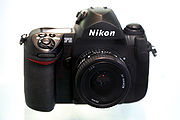
APS-C
Advanced Photo System type-C is an image sensor format approximately equivalent in size to the Advanced Photo System "classic" size negatives...
" sized sensors, approximately 16×24 mm in size. A handful of digital SLRs use "full frame" sensors, being 24×36 mm like 135 film. While film sales have declined dramatically as digital cameras have become more popular for still photography, 35 mm remains the most popular format for those who use film.
While they have shifted the vast majority of their product lines to digital, major camera manufacturers such as Canon and Nikon continue to make expensive professional-grade 35 mm film SLRs (such as the Canon EOS-1v
Canon EOS-1v
The Canon EOS-1v is a 35mm single-lens reflex camera from Canon's EOS series, released in 2000, it is the final film camera in Canon's landmark EOS-1 series of professional cameras...
and the Nikon F6
Nikon F6
The Nikon F6 is a 35mm single-lens reflex camera body that became commercially available during 2004, and is the sixth top-of-the-line professional film camera in Nikon's line since the introduction of the Nikon F in 1959...
). However, as of 2010, Canon no longer lists the EOS-1v on their US website, indicating that it may be discontinued. This would mark the end of an era for Canon EOS film cameras. Introductory 35 mm SLRs, compact film point-and-shoot cameras, and single-use cameras continue to be built and sold by a number of makers. Leica finally introduced the digital Leica M8
Leica M8
The Leica M8 is the first digital camera in the rangefinder M series introduced by Leica Camera AG on 14 September 2006. It uses a 10.3-megapixel Kodak KAF-10500 CCD image sensor.As of 15/07/2011, the most recent firmware version is 2.014.-Features:...
rangefinder in 2007, but continues to make its M series rangefinder cameras and lenses. A digital camera back
Digital camera back
A digital camera back is a device that attaches to the back of a camera in place of a film holder and contains an electronic image sensor. This lets cameras that were designed to use film take digital photographs...
for the Leica R9
Leica R9
The Leica R9 is a manual focus 35 mm single-lens reflex camera produced by the German firm of Leica as part of their R series of cameras. It was released in 2002, replacing the very similar Leica R8, upon which it improved in several aspects...
SLR camera was discontinued in 2007. On March 25, 2009, Leica discontinued the R9 SLR and R-series lenses.

